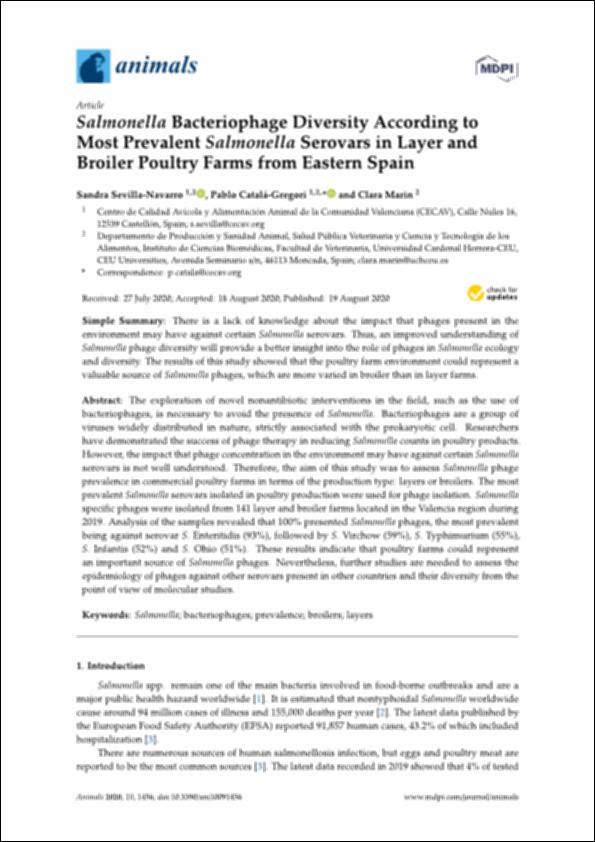Please use this identifier to cite or link to this item:
http://hdl.handle.net/10637/12498"Salmonella" bacteriophage diversity according to most prevalent "Salmonella" serovars in layer and broiler poultry farms from Eastern Spain
| Title: | "Salmonella" bacteriophage diversity according to most prevalent "Salmonella" serovars in layer and broiler poultry farms from Eastern Spain |
| Authors : | Sevilla Navarro, Sandra Catalá Gregori, Pablo Marín Orenga, Clara |
| Keywords: | Salmonellosis in animals - Spain - Valencia (Autonomous Community); Veterinary bacteriology.; Bacteriología veterinaria.; Poultry - Bacteriology.; Granjas avícolas - España - Comunidad Valenciana.; Bacteriophages.; Salmonelosis en los animales - España - Comunidad Valenciana.; Poultry hatcheries - Spain - Valencia (Autonomous Community); Aves de corral - Bacteriología.; Bacteriófagos. |
| Publisher: | MDPI |
| Citation: | Sevilla-Navarro, S., Catalá-Gregori, P. & Marin, C. (2020). "Salmonella" bacteriophage diversity according to most prevalent "Salmonella" serovars in layer and broiler poultry farms from Eastern Spain. Animals, vol. 10, i. 9 (19 aug.), art. 1456. DOI: https://doi.org/10.3390/ani10091456 |
| Abstract: | The exploration of novel nonantibiotic interventions in the field, such as the use of bacteriophages, is necessary to avoid the presence of Salmonella. Bacteriophages are a group of viruses widely distributed in nature, strictly associated with the prokaryotic cell. Researchers have demonstrated the success of phage therapy in reducing Salmonella counts in poultry products. However, the impact that phage concentration in the environment may have against certain Salmonella serovars is not well understood. Therefore, the aim of this study was to assess Salmonella phage prevalence in commercial poultry farms in terms of the production type: layers or broilers. The most prevalent Salmonella serovars isolated in poultry production were used for phage isolation. Salmonella specific phages were isolated from 141 layer and broiler farms located in the Valencia region during 2019. Analysis of the samples revealed that 100% presented Salmonella phages, the most prevalent being against serovar S. Enteritidis (93%), followed by S. Virchow (59%), S. Typhimurium (55%), S. Infantis (52%) and S. Ohio (51%). These results indicate that poultry farms could represent an important source of Salmonella phages. Nevertheless, further studies are needed to assess the epidemiology of phages against other serovars present in other countries and their diversity from the point of view of molecular studies. |
| Description: | Este artículo se encuentra disponible en la siguiente URL: https://www.mdpi.com/2076-2615/10/9/1456 |
| URI: | http://hdl.handle.net/10637/12498 |
| Rights : | http://creativecommons.org/licenses/by/4.0/deed.es |
| ISSN: | 2076-2615 (Electrónico). |
| Issue Date: | 19-Aug-2020 |
| Center : | Universidad Cardenal Herrera-CEU |
| Appears in Collections: | Dpto. Producción y Sanidad Animal, Salud Pública Veterinaria y Ciencia y Tecnología de los Alimentos |
Items in DSpace are protected by copyright, with all rights reserved, unless otherwise indicated.


